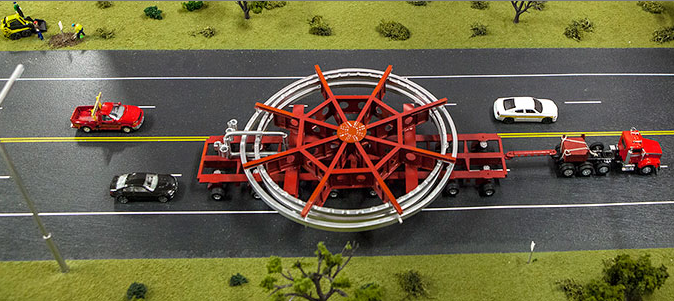Shipping A 50-Foot Magnet Across The U.S., For Physics
From New York, around Florida and up the Mississippi, all to study a subatomic particle that only lives two millionths of a second.

After the discovery of the Higgs boson last summer, particle physicists are exploring new avenues to help shed light on how the universe works. But the most intricate physics experiments need ginormous machinery, which is expensive and difficult to build. Rather than construct something from scratch, two of the nation’s premier physics labs are repurposing some old equipment. Transferring it to a new home will be a huge undertaking of its own.
In the suburbs outside Chicago, the Fermi National Accelerator Laboratory was once home to the world’s most powerful particle accelerator. After its storied Tevatron shut down, Fermilab scientists started looking to muons for the future. Muons are negatively charged subatomic particles, much heavier than electrons, and they’re interesting for several reasons, like their incredibly short lifespan: They last only 2.2 millionths of a second.
Muons wobble like a spinning top, and when they’re in a magnetic field, they start to rotate. The way they move, called gyromagnetic procession, can tell physicists very interesting things. At Brookhaven National Laboratory, physicists already have a device for measuring muons, so Fermilab scientists are in luck. Except the device is a 600-ton, 50-foot-diameter ring with cryogenically cooled magnets–not exactly easy to ship.
During a visit to Fermilab last fall, I learned about this device from Chris Polly, the project manager for a new muon experiment called Muon g-2. He didn’t seem fazed at all by the prospect of getting the huge muon ring from New York to northern Illinois. We have the Great Lakes and the Mississippi, after all.
This week, Brookhaven and Fermilab announced their plans to move the ring on an epic barge journey. The trip will be tense, because the ring’s massive electromagnet cannot tilt or twist more than a few degrees, or the wiring inside will be irreparably damaged. It will float from New York Harbor in June, down the East Coast, around Florida, up the Gulf Coast and up the Mississippi River by July.
Once it arrives in Illinois, the ring will be placed on a special truck built for this purpose. Last fall, Fermilab scientists measured the state’s highway toll booths to make sure it would fit. It will–with just four inches of clearance, as Polly told me at the time. It will drive at night, to minimize traffic delays.

Muon Storage Ring
When it arrives, scientists will re-assemble all the pieces and start using particle accelerators to produce muons, which will whip around inside it. “It’s like a holding pen for them; they are going at the speed of light,” Polly said.
Muon g-2 will look at some unusual quantum effects that take place on the subatomic scale, which Polly calls a “very strange world.” Particles pop in and out of existence, and heavy muons can coax them out. A new muon campus at Fermilab will enable new beams of muons that will end up in the Brookhaven storage ring. The ring produces an incredibly uniform magnetic field, which will allow physicists like Polly to see the particles’ weird gyrations and possibly new physics.
Like electrons, muons are in the lepton family. That means they’re not composed of other pieces–unlike protons and other hadrons. When hadrons collide, they break up into their constituent bits; when leptons collide, more energy goes into the collision, resulting in strange states of matter. Tiny muons are a big part of Fermilab’s future.
Muon 2-g is scheduled to begin taking data in 2016.